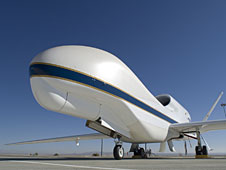THE DRYDEN FLIGHT RESEARCH CENTER, located at Edwards Air Force Base, Calif., is NASA's premier installation for atmospheric flight research and operations. NASA Dryden plays a vital role in carrying out the agency's missions of space exploration, space operations, scientific discovery, and aeronautical research and development. A sampling of current and recently completed projects includes:
 |
NASA operates a converted McDonnell Douglas DC-8 jetliner as an airborne science laboratory. The highly-modified aircraft, based at NASA Dryden Flight Research Center's Aircraft Operations Facility in Palmdale, Calif., serves as a platform for data collection on a wide variety of experiments in support of Earth and environmental science projects conducted by NASA, academia and various research institutions around the world.
|
|
 |
NASA is using two ER-2 aircraft, a civil derivative of the military U-2S reconnaissance aircraft, on high-altitude science missions. The aircraft, based at NASA's Dryden Flight Research Center, Edwards, Calif., collect information about our surroundings, including earth resources, celestial observations, atmospheric chemistry and dynamics, and oceanic processes. The aircraft also are used for electronic sensor research and development, satellite calibration, and satellite data validation.
|
|
 |
The F-15B Research Testbed is a modified twin-engine jet fighter that provides NASA, industry, and universities with long-term capability for the efficient flight test of aerodynamic, instrumentation, propulsion, and other flight research experiments.The F-15B Research Testbed is a unique airborne resource, a virtual "flying wind tunnel," among it's many capabilities.
|
|
 |
A modified Grumman Gulfstream III business jet is being used by NASA's Dryden Flight Research Center as a testbed for a variety of flight research experiments under the Multi-Role Cooperative Research Platform project. The heavily instrumented twin-turbofan aircraft provides long-term capability for efficient testing of subsonic flight experiments for NASA, the U.S. Air Force, other government agencies, academia, and private industry.
|
|
 |
NASA's Dryden Flight Research Center has acquired two developmental Northrop Grumman autonomously operated Global Hawk aircraft for use in high-altitude, long-duration Earth science missions.
|
|
 |
This project is validating the application of "self-learning" neural network software to aircraft digital flight control computers, using a highly-modified NF-15B and in the future an Air Force C-17 test aircraft.
|
|
 |
Orion Crew Exploration Vehicle
Dryden is playing a significant role in the development of the next-generation spacecraft, including conducting preliminary definition and planning for Orion CEV launch abort systems tests, drop tests, landing and recovery tests, re-entry and landing profiles, range safety requirements and integration, flight test support and independent analysis.
|
|
 |
NASA Dryden continues to support NASA’s human space flight program as an alternate landing site for the space shuttle orbiters. Dryden has been the site of 50 space shuttle landings since the first orbital flight in April 1981, most recently the landing of shuttle orbiter Discovery at the end of mission STS-114 in August 2005. After an Edwards landing, orbiters are serviced at Dryden for ferry flights back to Kennedy Space Center in Florida atop one of NASA’s two modified Boeing 747 Shuttle Carrier Aircraft.
|
|
 |
NASA Dryden is conducting science systems installation and integration and flight testing of SOFIA, a world-class airborne observatory complementing the Hubble Space Telescope and ground-based telescopes. The observatory features a German-built 2.5-meter diameter infrared telescope mounted in a highly-modified Boeing 747SP aircraft. SOFIA is a joint program by NASA and the German Aerospace Center (DLR).
|
|
 |
NASA and the U.S. Forest Service successfully demonstrated technologies that improved real-time wildfire imaging and mapping capabilities during a series of research flights by the Ikhana unmanned research aircraft in late 2007.
|
|
 |
Boeing Phantom Works' unique X-48B Blended Wing Body technology demonstrator is undergoing flight tests at NASA Dryden Flight Research Center. The 8.5 percent scale, remotely piloted X-48B is a cross between a conventional aircraft and a flying wing design. Flight tests are intended to validate the potential advantages of the blended wing body aerodynamic concept.
|
|
Research Facilities
Research Facilities at NASA Dryden Flight Research Center provide its pilots, engineers, scientists and technicians a unique and highly specialized capability to conduct flight research programs unmatched anywhere in the world. These facilities incorporate advanced and innovative processes to meet our customers' evolving requirements on time, every time. These facilties include:
Thousands of technical reports and papers written by NASA Dryden engineers about various aspects of flight research projects conducted at the center over the past six decades are available either on-line on the Dryden Technical Reports Server, which is part of the NASA Technical Report Server, or in hard copy form from the NASA Center for Aerospace Information or the National Technical Information Service. The Dryden Technical Reports Server is a database of Abstracts, Citations and full text Technical Reports written by and for the scientific and technical community. For more information, log onto http://www1.nasa.gov/centers/dryden/news/DTRS/.
|










